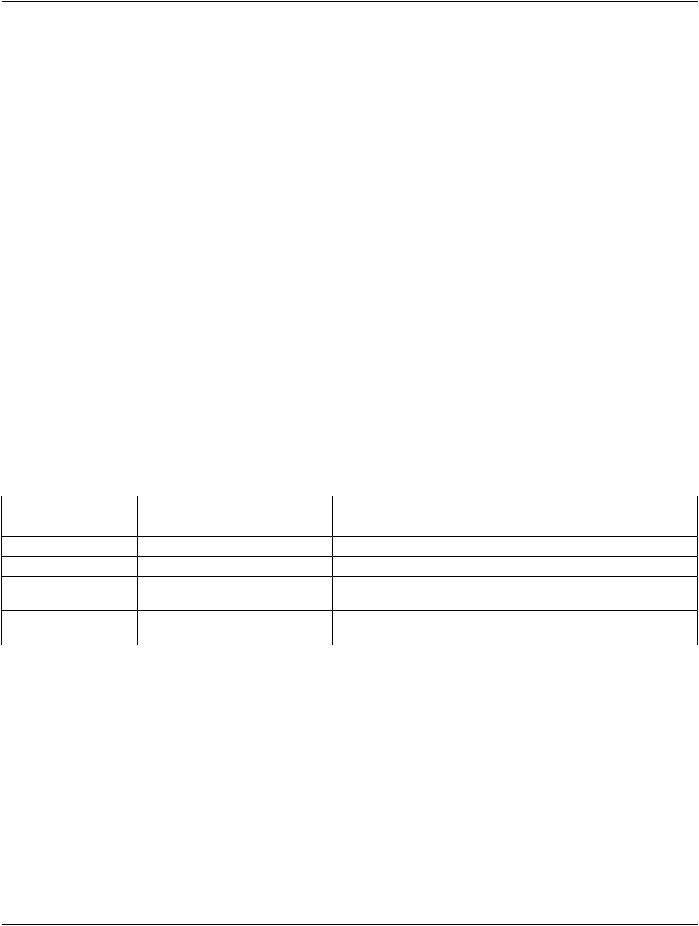
PS-2020a / part12
.pdf
DICOM PS3.12 2020a - Media Formats and Physical Media for Media Interchange |
Page 71 |
Options or extensions defined in UDF are required or restricted as specified in the following sub-sections, and in the media specific sub-sections.
Note
Though the names of the files within the DICOM File set are restricted by PS3.10, other files on the media may have longer file names.
P.2.1.1 Interchange Levels
For the UDF Primary Volume Descriptor, both the Interchange Level and Maximum Interchange Level shall always be set to 2.
Note
1.This means that the volume is not and will never be, part of a multi-volume set.
2.The Interchange Level and Maximum Interchange Level in the File Set Descriptor are defined by UDF to always be 3. This is despite the fact that restrictions specified for the DICOM File-set may be very similar to lower Interchange Levels specified in ECMA 167.
P.2.1.2 Virtual Partition Map and Allocation Tables
Creators and updaters may or may not write UDF Virtual Partition Maps and Virtual Allocation Tables depending on the appropriate choice for physical media.
All readers are required to support UDF Virtual Partition Maps and Virtual Allocation Tables.
P.2.1.3 Sparable Partition Maps and Sparing Tables
Creators and updaters may or may not write UDF Sparable Partition Maps and Sparing Tables depending on the appropriate choice for physical media, since defect management may or may not be performed in the drive.
All readers are required to support UDF Sparable Partition Maps and Sparing Tables.
P.2.1.4 System Dependent Requirements
The reader shall not depend on any system dependent requirements as specified in UDF to be able to read the DICOM File-set, and shall not behave differently if they are present. Any unrecognized system dependent requirements shall be gracefully ignored.
Creators and updaters writing to a version of UDF that supports Named Streams shall use the default stream to write each file within the DICOM File-set.
Note
1.For example, a particular form of file permissions, particular extended attributes or particular named streams may not be required or affect application behavior.
2.This does not mean that Extended Attributes or Named Streams may not be present and associated with files within the DICOM File-set.
P.2.1.5 Permissions and File Characteristics
Creators and updaters shall always create permissions for files within the DICOM File Set such that all users may read, write and delete all files, and all users may access and delete all directories on all systems.
Note
1.These requirements are equivalent to setting a Unix permission of 644 for files and 755 for directories.
2.The intent of these requirements is that for DICOM interchange media, implementation specific access control is not used or required.
- Standard -

Page 72 |
DICOM PS3.12 2020a - Media Formats and Physical Media for Media Interchange |
The UDF File Identifier Descriptor for files within the DICOM File Set shall not specify a File Characteristic of "hidden."
P.2.1.6 File Types
The UDF File Types within the DICOM File Set shall only be files (that is a File Type of 0, meaning unspecified interpretation) or symbolic links to files (that is a File Type of 12).
P.2.2 ISO 9660 File System
ThereadershallbeabletoreadalogicalformatconformingtoISO9660Level1,2and3,withorwithoutRockridgeorJolietExtensions, which may or may not be present.
The creator shall be able to create a logical format conforming to ISO 9660 Level 1, 2 or 3, and may or may not add Rockridge or Joliet Extensions.
Note
Though the files within the DICOM File set are restricted to names that conform to a subset of ISO 9660 Level 1, other files on the media may have longer file names. Unlike the Annex of this Part specifying CD-R media, strict Level 1 conformance of the file system is not required, since this has proven difficult to constrain in practice.
P.2.2.1 Extended Attributes, Permissions and File Characteristics
File modification data, file owner identification, and permissions are part of the ISO 9660 - Extended Attribute Record. Support of the Extended Attribute Record is not required.
If Extended Attribute Records are present, all files within the DICOM File Set shall have permissions such that all users may read all files, and all users may access all directories on all systems.
Note
The intent of these requirements is that for DICOM interchange media, implementation specific access control is not used or required.
P.3 Media Formats
P.3.1 DVD
P.3.1.1 DVD Physical Format
The physical format of DVD media shall comply with one of the following applicable definitions:
•DVD Specifications for Recordable Disc (DVD-R for General) : Part 1 - Physical Specifications Version 2.0
•DVD Specifications for Recordable Disc (DVD-R for Authoring) : Part 1 - Physical Specifications Version 2.0
•DVD Specifications for Read-Only Disc (DVD-ROM) : Part 1 - Physical Specifications Version 1.13
•DVD Specifications for Re-Recordable (DVD-RW) : Part 1 - Physical Specifications Version 1.1
•DVD+RW Physical Specifications, Version 1.1
•DVD+R Physical Specifications, Version 1.1
P.3.1.1.1 DVD Sector Format
The sector format of DVD media shall comply with one of the following applicable definitions:
•DVD Specifications for Recordable Disc (DVD-R for General) : Part 2 - File System Specifications Version 2.0
•DVD Specifications for Recordable Disc (DVD-R for Authoring) : Part 2 - File System Specifications Version 2.0
- Standard -

DICOM PS3.12 2020a - Media Formats and Physical Media for Media Interchange |
Page 73 |
•DVD Specifications for Read-Only Disc (DVD-ROM) : Part 2 - File System Specifications Version 1.13
•DVD Specifications for Re-Recordable Disc (DVD-RW) : Part 2 - File System Specifications Version 1.0
•DVD+RW Defect Management & Physical Formatting Specification, Version 1.0
No restrictions are placed on the use of disc-at-once, track-at-once, multi-session or packet-written format if applicable to the physical media type, other than that any session should be finalized at the conclusion of writing the media in order to make it readable.
P.3.1.2 DVD Logical Format
There are no requirements, restrictions, options or extensions to the logical format that are specific to this media type, beyond those specified in Section P.2.
P.3.1.3 DVD Physical Media
The physical medium shall be the 120 mm DVD-R medium as defined in one of the following:
•DVD Specifications for Recordable Disc (DVD-R for General) : Part 1 - Physical Specifications Version 2.0 •DVD Specifications for Recordable Disc (DVD-R for Authoring) : Part 1 - Physical Specifications Version 2.0 •DVD Specifications for Read-Only Disc (DVD-ROM) : Part 1 - Physical Specifications Version 1.13
•DVD Specifications for Re-Recordable (DVD-RW) : Part 1 - Physical Specifications Version 1.1 •DVD+RW Physical Specifications, Version 1.1
•DVD+R Physical Specifications, Version 1.1
- Standard -

Page 74 |
DICOM PS3.12 2020a - Media Formats and Physical Media for Media Interchange |
- Standard -

DICOM PS3.12 2020a - Media Formats and Physical Media for Media Interchange |
Page 75 |
Q 90 mm 2.3 GB Magneto-Optical Disk (Normative)
Q.1 DICOM Mapping to Media Formats
Only one DICOM File-set shall be stored onto a single 90mm disk.
Q.2 Media Formats
The media format comprises two distinct components:
a.The Recording format, which addresses magnetic recording, track definition, sector headers, etc.
b.The Logical format, which addresses the organization of the data portion of sectors to support semantics of the file system.
Q.2.1 Recording Format
ThelowlevelformattingshallbedoneusingtheGIGAMOstandard.GIGAMOispublishedasaSony-Fujitsudocumentandiscurrently not an ISO/IEC standard. The document specifying this formatting is the "GIGAMO 2.3GB 90mm Magneto-Optical Disk System in Cherry Book2 version 1.0". The Secondary Defect List shall be used.
Q.2.2 Logical Format
The Logical Format for the 90mm 2.3GB disk shall be the PC File System (Annex A).
The boot sector defined in Annex A shall have the following values.
Table Q.2-1. Boot Parameter Values for 90mm 2.3 GB Magneto-Optical Disk
Byte(s) |
Value |
Description |
11 - 12 |
0800H |
2048 Bytes/Sector |
13 |
08H, 10H, 20H, or 40H |
Sectors / cluster, either 8, 16, 32, or 64 |
21 |
F8H |
Flag for disk type F8H = Hard Disk |
24-25 |
0019H (Nominal) |
Nominally 25 sectors/track, but may vary, and any value should not |
|
|
affect interoperability |
26-27 |
0001 (Nominal) |
Nominally 1 head, but may vary, and any value should not affect |
|
|
interoperability. |
Note
When formatted the total formatted capacity of the disk is approximately 2.02GB.
Q.3 Physical Media
The physical media shall be the 90mm Magneto-Optical Rewritable disk with 2048 bytes per sector. It shall be compatible with the R/W Type cartridge defined in the "GIGAMO 2.3GB 90mm Magneto-Optical Disk System in Cherry Book2 version 1.0".
- Standard -

Page 76 |
DICOM PS3.12 2020a - Media Formats and Physical Media for Media Interchange |
- Standard -

DICOM PS3.12 2020a - Media Formats and Physical Media for Media Interchange |
Page 77 |
R USB Connected Removable Devices
R.1 DICOM Mapping to Media Formats
Only one DICOM file set shall be stored in the first partition of a partitioned device. If the device is not partitioned, only one DICOM file set shall be stored on the device.
R.1.1 File System
The file system employed on these media shall be either the FAT16 file system or the FAT32 file system. The information in the boot sector of this partition shall be utilized by the file system to determine proper access to this media (see Microsoft Extensible Firmware Initiative FAT32 File System Specification).
File names used for DICOM files shall be further restricted to be in compliance with the File ID rules specified in PS3.10. The File ID shall be the same as the filename.
Note
These rules limit the character set to being a subset of the DICOM default G0 character set, limit the file names to be no more than 8 characters, and limit the directory tree to be no more than 8 levels deep. All of these restrictions are needed to comply with the most limited of the removable media.
R.2 Media Formats
R.2.1 Partitioning
These media may be partitioned or unpartitioned. The more common usage is partitioned.
Note
Operating system support for unpartitioned media varies. Most current operating systems expect partitioned media. Some restrict their support further and only support access to the first partition of this media. These support decisions are being driven by the high volume consumer items that utilize these mechanisms, such as digital cameras.
R.3 Physical Media Interface
These devices may have a wide variety of overall physical characteristics. They shall provide a connector that complies with the USB 1.1 or 2.0 specifications for physical, electrical, signaling, and communications protocol. The electrical signaling and lower level USB protocol support shall comply with the USB 1.1 or 2.0 specifications. The device shall act as a Mass Storage Device, in accordance with the USB Mass Storage Class, as described in the Universal Serial Bus Mass Storage Class, Specification Overview and its subordinate and referenced documents.
Note
1.The USB base standard and the USB mass storage device standard includes specification for management of device addition and removal, and for negotiation of device command protocol capabilities. Support for these is normally part of the functions provided by the USB Mass Storage driver in an operating system.
2.The USB 2.0 specification specifies 3 speeds of operation, "low-speed", "full-speed" and "high-speed", which are fully interoperable, and this profile does not distinguish between the speeds.
3.The intent is to allow removable 1.1 and 2.0 USB media to interoperate with 1.1 and 2.0 USB devices.
- Standard -

Page 78 |
DICOM PS3.12 2020a - Media Formats and Physical Media for Media Interchange |
- Standard -

DICOM PS3.12 2020a - Media Formats and Physical Media for Media Interchange |
Page 79 |
S CompactFlash Removable Devices
S.1 DICOM Mapping to Media Formats
Only one DICOM file set shall be stored in the first partition of a partitioned device. If the device is not partitioned, only one DICOM file set shall be stored on the device.
S.1.1 File System
The file system employed on these media shall be either the FAT16 file system or the FAT32 file system. The information in the boot sector of this partition shall be utilized by the file system to determine proper access to this media (see Microsoft Extensible Firmware Initiative FAT32 File System Specification).
File names shall be further restricted to be in compliance with the File ID rules specified in PS3.10. The File ID shall be the same as the filename.
Note
These rules limit the character set to being a subset of the DICOM default G0 character set, limit the file names to be no more than 8 characters, and limit the directory tree to be no more than 8 levels deep. All of these restrictions are needed to comply with the most limited of the removable media.
S.2 Media Formats
S.2.1 Partitioning
These media may be partitioned or unpartitioned. The more common usage is partitioned.
Note
Operating system support for unpartitioned media varies. Most current operating systems expect partitioned media. Some restrict their support further and only support access unpartitioned media or to the first partition of partitioned media.
S.3 Physical Media Interface
The physical, electrical, signaling, and software interface shall comply with the CF+ and CompactFlash Specification.
- Standard -

Page 80 |
DICOM PS3.12 2020a - Media Formats and Physical Media for Media Interchange |
- Standard -
